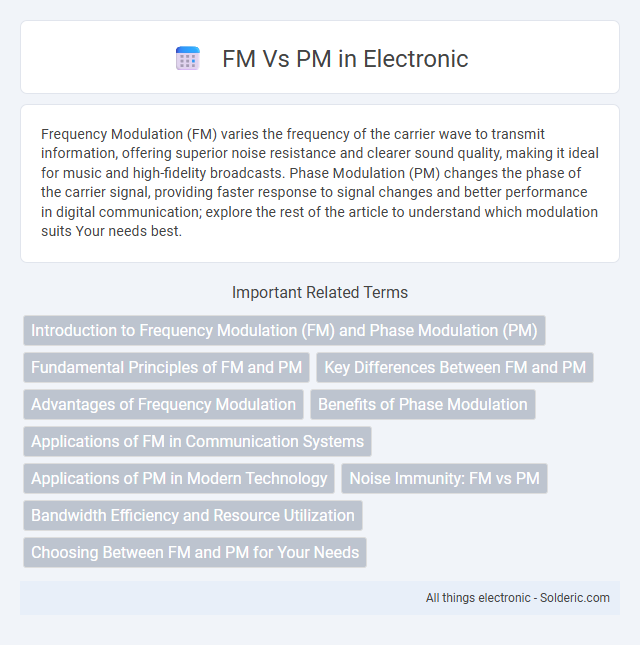Frequency Modulation (FM) varies the frequency of the carrier wave to transmit information, offering superior noise resistance and clearer sound quality, making it ideal for music and high-fidelity broadcasts. Phase Modulation (PM) changes the phase of the carrier signal, providing faster response to signal changes and better performance in digital communication; explore the rest of the article to understand which modulation suits Your needs best.
Comparison Table
| Aspect | Frequency Modulation (FM) | Phase Modulation (PM) |
|---|---|---|
| Definition | Modulates the frequency of the carrier based on the message signal. | Modulates the phase of the carrier according to the message signal. |
| Modulating Parameter | Instantaneous frequency changes. | Instantaneous phase changes. |
| Spectrum | Bandwidth depends on message frequency and modulation index (Carson's Rule). | Similar to FM but phase deviation relates directly to modulating signal amplitude. |
| Noise Immunity | Better noise resistance compared to AM; less affected by amplitude noise. | Comparable noise immunity; sensitive to rapid phase changes. |
| Applications | FM radio broadcasting, sound synthesis, telemetry. | Digital modulation techniques, angle modulation systems. |
| Complexity | Moderate complexity in demodulation (discriminator or phase-locked loop). | Typically more complex due to phase tracking requirements. |
Introduction to Frequency Modulation (FM) and Phase Modulation (PM)
Frequency Modulation (FM) encodes information by varying the instantaneous frequency of a carrier signal, while Phase Modulation (PM) changes the phase of the carrier wave to convey data. Both FM and PM are types of angle modulation used extensively in telecommunications and signal processing due to their robustness against noise and interference. Understanding the fundamental differences between FM and PM enables you to select the appropriate modulation technique for efficient and high-quality communication systems.
Fundamental Principles of FM and PM
Frequency Modulation (FM) encodes information by varying the carrier wave's frequency in direct proportion to the input signal's amplitude, maintaining constant amplitude throughout transmission. Phase Modulation (PM) alters the carrier's phase angle based on the instantaneous amplitude of the message signal, resulting in phase shifts that correspond to the signal information. Your choice between FM and PM depends on factors like noise immunity, bandwidth requirements, and system complexity, as both modulations manipulate different carrier wave parameters to transmit data efficiently.
Key Differences Between FM and PM
Frequency Modulation (FM) varies the carrier signal's frequency according to the input signal, while Phase Modulation (PM) changes the carrier's phase based on the input. FM provides better noise immunity and is widely used for high-fidelity audio broadcasting, whereas PM is commonly employed in digital signal processing and communication systems. Understanding these key differences helps you choose the appropriate modulation technique for your specific application and performance requirements.
Advantages of Frequency Modulation
Frequency Modulation (FM) offers significant advantages including superior noise resistance, which ensures clearer audio signals in broadcasting and communication systems. FM's constant amplitude signal reduces distortion and signal degradation over long distances, enhancing your listening experience. The wider bandwidth capacity of FM allows for higher fidelity sound and better overall quality compared to Phase Modulation (PM).
Benefits of Phase Modulation
Phase modulation (PM) offers superior noise immunity compared to frequency modulation (FM), making it ideal for high-fidelity communication systems in noisy environments. PM provides efficient bandwidth utilization by maintaining constant amplitude, which reduces signal distortion and enhances transmitter efficiency. Its ability to directly encode phase information allows for improved signal integrity and better performance in digital communication applications such as phase shift keying (PSK).
Applications of FM in Communication Systems
Frequency Modulation (FM) is widely used in communication systems for its superior noise immunity and high-fidelity audio transmission. FM is the preferred method for commercial radio broadcasting, two-way radio communication, and television sound transmission due to its resilience against signal strength variations and interference. Its ability to provide clear and reliable audio signals makes FM essential in emergency communication networks and mobile radio systems.
Applications of PM in Modern Technology
Phase modulation (PM) is integral to modern communication systems such as satellite transmissions, where its robustness against signal degradation ensures reliable data transfer. PM's application in digital modulation techniques, including quadrature phase-shift keying (QPSK), enhances bandwidth efficiency and signal integrity in wireless networks and cellular communications. Furthermore, PM is utilized in radar systems for precise target detection and in optical fiber communications to support high-speed data transmission.
Noise Immunity: FM vs PM
Frequency Modulation (FM) exhibits superior noise immunity compared to Phase Modulation (PM) because noise primarily affects amplitude rather than frequency, allowing FM to suppress amplitude-based interference effectively. PM, while closely related to FM, is more susceptible to phase noise and rapid phase shifts, which can degrade signal quality under certain conditions. Signal-to-noise ratio (SNR) performance in FM systems is generally higher, making FM ideal for environments with substantial amplitude noise interference.
Bandwidth Efficiency and Resource Utilization
Frequency Modulation (FM) typically requires wider bandwidth compared to Phase Modulation (PM) for the same message signal, making PM more bandwidth efficient. PM allows for better spectral efficiency and optimized resource utilization in communication systems, reducing interference and maximizing channel capacity. Your choice between FM and PM affects how effectively the available spectrum and power resources are employed, with PM often preferred in bandwidth-constrained environments.
Choosing Between FM and PM for Your Needs
Choosing between Frequency Modulation (FM) and Phase Modulation (PM) depends on your specific application requirements, such as bandwidth efficiency, noise immunity, and signal complexity. FM is preferred for audio broadcasting due to its superior noise resistance and simpler demodulation process, while PM excels in data communication systems where phase variations carry information more efficiently. Understanding these distinctions ensures you select the modulation technique that optimizes performance and meets your communication needs.
FM vs PM Infographic

 solderic.com
solderic.com